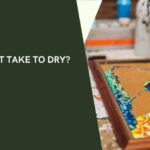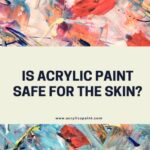Acrylic paint on glass – With its smooth, transparent quality, glass has always held a certain allure for artists. While stained glass windows boast a rich history of storytelling through vibrant colours, the desire to create art directly on glass surfaces extends beyond traditional techniques. Enter acrylic paint—a versatile medium that can breathe new life into glassware, windows, and other glass objects. But the question remains: Can you use acrylic paint on glass?
The answer, like most things in art, is nuanced. While acrylic paint can adhere to glass to some extent, achieving a long-lasting, chip-resistant finish requires proper preparation. This blog delves into the world of painting on glass with acrylics, exploring the possibilities, the “hows,” and the “whys” to ensure your glass masterpiece transcends fleeting beauty.
Does Acrylic Paint Work on Glass?
Acrylic paint, a water-based favourite among artists and crafters, boasts numerous advantages. It’s fast-drying, easy to clean up, and has various colours and finishes. However, its water-based nature challenges adhesion on non-porous surfaces like glass. The paint struggles to form a strong bond with the slick surface, leading to potential chipping, peeling, and paint failure.
How to paint on glass?
The key lies in priming the glass before applying the paint. Primers act as a bridge between the paint and the glass, creating a slightly textured surface that allows the paint to adhere much better. Glass primers are specially formulated to withstand the expansion and contraction of glass due to temperature changes, further ensuring a durable finish.
Experiment with translucent layers of acrylic paint to achieve depth and luminous effect, or employ techniques such as stippling, sponging, or stencilling to add texture and dimension to your creations.
Priming Glass for Acrylic Paint
Now that you understand the importance of priming glass, let’s explore the different options available:
Glass Primer for Acrylic Paint
This approach is the most straightforward and recommended. Look for primers labelled explicitly for use with acrylic paints on glass surfaces. These primers often come in spray paint cans or brush-on varieties, making application a breeze.
Multi-Surface Primers
Some acrylic paint manufacturers offer multi-surface primers that claim to eliminate the need for a separate primer coat on glass. While convenient, their effectiveness may vary depending on the paint quality and the desired durability. Always test a small area before committing to an entire project.
Priming Tips for a Flawless Finish
- Cleanliness is Key: Thoroughly clean the glass surface before applying primer or paint. Using a degreaser or a mild abrasive cleaner, remove dirt, grease, and any existing dust. Rinse well and allow the glass to dry completely.
- Sanding for Better Bonding: Lightly sand the glass surface with fine-grit sandpaper for extra adhesion. This creates microscopic scratches that enhance the primer’s ability to grip the glass.
- Follow the Instructions: Different primers have varying drying times and application recommendations. Ensure you follow the specific instructions on the product label for optimal results.
Can You Use Acrylic Paint on Glass Without Primer?
Yes, you can apply acrylic paint directly to glass. However, as mentioned earlier, this approach is not recommended for long-lasting projects. The paint is more prone to chipping, peeling, and wear and tear without a primer.
Like frosted or etched glass, glasses with a slight texture offer better natural adhesion for acrylic paint than smooth, polished glass. In some cases, you might get away with using acrylic paint directly on these surfaces, especially for small, low-traffic projects. However, priming is always recommended for best results.
How to choose the perfect paint for your glass painting project
Let’s explore some top contenders that, when paired with proper priming, will help you transform your glass canvas into a masterpiece:
Factors to Consider When Choosing Acrylics for Glass
- Adhesion: Look for acrylic paints specifically formulated for glass painting. These paints often contain additives that enhance their bonding properties to the primed glass surface.
- Transparency: Opt for transparent acrylic paints for a vibrant, stained-glass effect. These allow light to pass through, creating a luminous quality on the glass.
- Durability: While acrylics offer good durability on primed glass, consider using artist-grade paints for projects requiring extra resistance to fading and chipping.
- Brand Reputation: Choose glass permanent paint brands known for their high-quality acrylic paints. These brands are more likely to offer paints formulated explicitly for glass painting with superior adhesion properties.
Top Picks for Acrylic Paints on Glass
Below, I’ve listed some of the best paints for glass DIY projects.
- Liquitex BASICS Acrylic Ink: This versatile option comes in a wide range of vibrant, transparent colours. It is perfect for creating layered effects and achieving a stained-glass aesthetic on primed glass.
- Golden Fluid Acrylics: Renowned for their artist-grade quality, Golden Fluid Acrylics offer exceptional fluidity and transparency. They are ideal for creating detailed designs and smooth colour transitions on primed glass surfaces.
- Delta Ceramcoat Studio Acrylics: A budget-friendly option with a good selection of transparent and opaque colours, Delta Ceramcoat Studio Acrylics work well on primed glass for decorative and functional projects.
- Amsterdam Acrylics: Amsterdam Acrylics come in various colours, including a good selection of transparent options. They are a versatile choice for glass painting on primed surfaces.
- Jacquard Lumiere Acrylics: Specially formulated for mixed-media applications, Jacquard Lumiere Acrylics boast excellent adhesion to various surfaces, including primed glass. This makes them a good option for projects using different materials.
Glass painting Ideas
Here are some ideas for painting on glass that you can try at home. Simple and cute!
Transform old windows
Breathe new life into old windows by creating a stained-glass effect with transparent paint for stained glass. Geometric patterns, floral motifs, or landscapes can be stunningly recreated on glass.
Decorative suncatchers
Design charming suncatchers using paint for stained glass. Small glass panels can bring birds, butterflies, or geometric shapes to life. Hang them in your window to enjoy the vibrant colours dancing with the sunlight.
Wine glass paint ideas
Create a set of one-of-a-kind paintable wine glasses for each guest at your next dinner party. Use their initials, birthstones, or favourite colours for a personal touch.
Themed wine glasses
For a festive gathering, design wine glasses for painting with a specific theme. Wine and grapes for a wine tasting, spooky silhouettes for Halloween, or snowflakes for a winter party.
Floral explosion
Transform a plain painted vase into a blooming masterpiece by painting vibrant flowers or abstract floral patterns that cascade up the sides of the vase.
Painted vases
Use the ombre technique to create a captivating effect on your painted vases—layer shades of the same colour for a smooth transition from light to dark.
Abstract swirls
Unleash your inner artist and create captivating paintings on glass. Use fluid acrylics for swirling patterns and vibrant colours.
Coastal Painting
Capture the beauty of the ocean on a framed glass panel. Paint crashing waves, a serene beach scene, or colourful fish for a coastal-inspired masterpiece.
Upcycled bottles
Give new life to old glass bottles with glass painting on glass bottles. They can be transformed into decorative centrepieces, colourful candle holders, or whimsical bud vases.
Decorated glassware
Personalize paint for glassware like drinking glasses, plates, or bowls. Paint geometric patterns, inspiring quotes, or playful designs to create a unique set.
Conclusion
Acrylic paint on glass – From painted glassware to intricate glass paintings, the fusion of acrylic paint and glass offers a captivating journey of exploration and discovery. So, can you use acrylic paint on glass? Absolutely.













